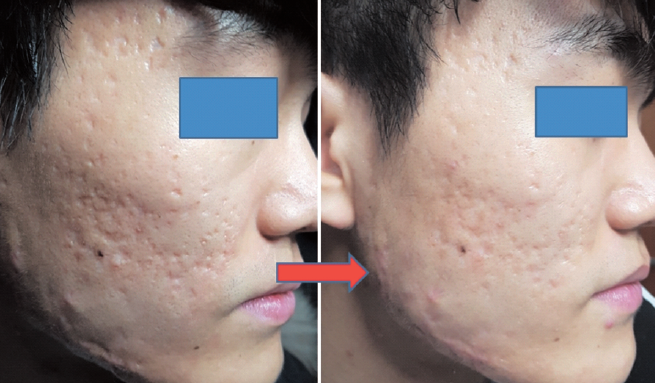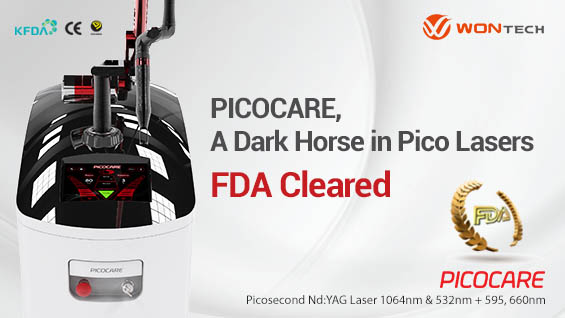Irradiating 100ps pulse duration on melanin with SRT of 10ps creates shock waves at the center of melanin, however, does not bring stress confinement. This leads to shock waves from melanin attacking melanosome. However, of all Laser devices available today, the picosecond Laser causes the least melanosome damage. The TRT of nanosecond Laser is within thermal confinement but fails to protect melanocytes from the destructive effects of shockwaves. The most common complications arising from melanocyte destruction are pigmentation and PIH. In my clinical experience, the picosecond Laser was superior to nanosecond Laser in terms of melasma removal. The efficacy is similar between the two Lasers but the picosecond Laser causes markedly fewer complications.

Image 5. After one treatment of PICOCARE acne scar removal.
LIOB Promotes Wound Healing Process
Another reason for choosing the picosecond Laser is LIOB(Laser induced optic breakdown). Imagine a picosecond Laser with a fractional handpiece, in other words, a fractional picosecond Laser. One fractional beam emits 23J. This is a very high power density for picosecond Laser and leads to tissue destruction through plasma formation. In lithotripsy, irradiating Laser on a stone results in not pulverization but complete disappearance. LIOB refers to the small spaces that occur when Laser plasma is irradiated on the epidermis or dermis. The fractional beam of picosecond Laser focuses energy in these spaces. Electron plasma increases to create plasma ball which leads to formation of empty spaces with minimal heat.
The 532ps PICOCARE creates LIOB within the epidermis to accelerate the wound healing process. This allows acne scar removal and skin rejuvenation treatments. Using the MLA(micro lens array) handpiece can improve the dermal environment. Fractional energy is generated from each clearly defined micro spot and the energy level is consistent with little loss. In my clinical experience, MLA seems more powerful and stable than DOE(diffractive optical element). Attending a demonstration session would help those not familiar with the picosecond Laser to learn more about the energy level and outcomes.
.jpg)
Image 6. Attendees showed a lot of interest in the picosecond Laser and asked many questions during Live Workshop.
Live Demonstration
If you are confident about avoiding the dermo-epidermal junction, you can use high energy levels with picosecond Laser without worrying about the risk of complications. I chose PICOCARE after being convinced of its safety by examining the histological results. For rejuvenation, I use spot size 10mm, at 0.2J. This is a very low energy level. My technique is to use a large spot size and low energy for toning. No visible changes are seen. Although invisible, you need to imagine a great amount of LIOB is formed. You can imagine that many micro vacuum holes form under the dermis. As mentioned above, it is important to check the number of shots in picosecond Laser treatment. Many of my melasma patients tell me even their wrinkles and skin texture improved after the melasma treatment with picosecond Laser. Another advantage is that treatments are quick and fast-paced.
[Advertisement] PICOCARE - Manufacturer: WONTECH(www.wtlaser.com)
For whitening, I use 532ps at 0.1J. At 532ps, you need to imaging LIOB is formed on the epidermis. Drastic improvement is seen as pigments are cleared away. 532ps is slightly excessive, so keep the procedure short and limit to only 600 shots per cheek. Remember to pass the handpiece more thoroughly over the cheekbones and cheek areas. Finish up with PDRN or gross factor.




















